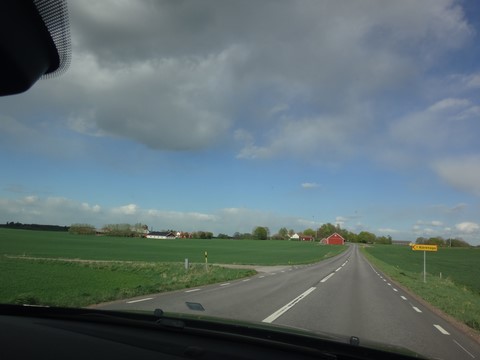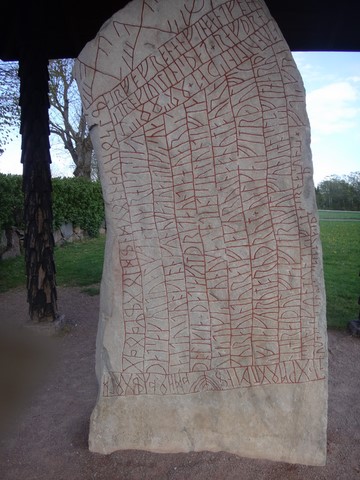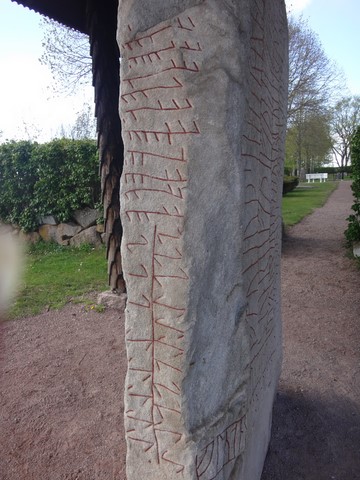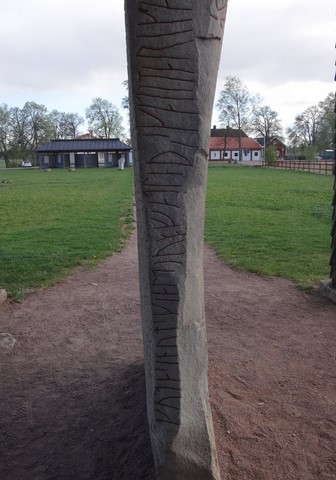The Nine End of the World Riddles of the Rök-runestone tell of climate anguish1200-y ago

On May 2nd, 2019, on a visit to Sweden, I had the pleasure of being driven by our old friend Rolf Classon, the well-known Swedish comics book publisher, from his home in Southern Sweden to Stockholm. Along the road, Rolf left the main highway and stopped at a lovely spot in the middle of the country-side, to show me an object he thought might interest me: the Rök-stone, a runestone with the longest runic message in the world. I had never heard of it. It did not look like it was attracting crowds, and was unguarded. The object in itself was impressive, but accompanying explanations pointed out that its meaning remained obscure and controversial, and indeed the translation provided on a flyer on the site read like gibberish. I didn't think I would hear much soon about the Rök-stone again. To my surprise, a few days ago, on January 8, 2020, the prestigious Swedish University of Uppsala announced that the Rök-stone had been deciphered, and that it tells a story of paternal grief, a fear of climate change and of impending natural disaster . A.M. de G.
Mystery-surrounded Rök-runestone testifies to 1,200-y old climate anguish

After over a thousand years, the Rök-stone, one of the greatest mysteries of the early Viking Age, seems to have yielded its message. According to four Swedish researchers, the enigmatic script conceals fear of climate change and a premonition of impending doom for Earth.
The Rök-stone, probably the best-known runestone of the Viking Age, has for centuries been a stumbling block for both scientists and historians. But now, more than a millennium after the stone was erected in this Östergötland parish, an interdisciplinary group of experts has offered an interpretation that bears witness to a dead son, a grieving father and, above all, concern about the climate and imminent natural disaster.
"We are four researchers who have been working together for two years, and in bringing together our efforts in our various academic fields - archeology, religious history, runology and the Swedish language - we have been able to bring forth an old man's reflections on his dead son," according to Henrik Williams, professor of Nordic languages at Uppsala University.

- Bo Gräslund, professor of archeology, Uppsala University
- Per Holmberg, professor of Swedish language, University of Gothenburg (project manager)
- Olof Sundqvist, Professor of Religious History, Stockholm University
- Henrik Williams, professor of Nordic languages, Uppsala University
According to the researchers, the text tells of the father seeking comfort in the fact that his son, a victorious military leader, has been called to Odin in order to fight at his side in Ragnarök, the final battle that will bring about the return of the sun and of light. The meaning is in agreement with the ancient Norse mythology of the time and when the Rök-stone was erected in the early 800's, the foreboding of an End of the World spread fear among the populations in the wake of a series of devastating disasters and heavenly phenomena which remained unexplainable to the people of the time.
We can place the Rök-stone's erection in time with relative certainty, but there are fewer than a hundred runestones known to date back to that period. And unlike later runestones that often have a similar content, these early creations show variations in the message which generally make them more difficult to interpret, according to Henrik Williams. In addition, the Rök-stone is written in various forms of ciphers, which certainly must have posed a challenge for contemporary readers as well.
Only a few would have understood
The 760-character message makes the Rök-stone the world's longest runic inscription. The fact that the carvings spell out the names of several kings indicates that the family which raised the stone belonged to the upper-crust of their society, and a possible desire for exclusiveness could explain its complex structure: only the "happy few" would understand the full meaning of the text.
Yet, according to the researchers' interpretation, the framework of the text consists of nine riddles, of which five refer to the sun and the remaining four to Odin and his warriors. Henrik Williams also draws attention to previously undetected links to other Nordic texts:
Our knowledge of this period is relatively limited. What we know is largely derived from the Icelandic Eddas. Our work, in my opinion, identifies clear parallels with the Eddas, which strengthens hypotheses about a common stock of mythological stories. We have similar discoveries from Gotland which go even further back in time, but for me, this is like finding a new literary source from the early Viking age.
Interdisciplinary cooperation

The group's scientific work was based on previous research. Key contributions have been made by Professor Bo Ralph, a member of the Swedish Academy, who in 2007 already questioned the previously prevailing interpretation that the Rök-stone states that Theodorik the Great had died nine generations before its erection. However, according to Henrik Williams, it was the interdisciplinary interaction between representatives of different universities that finally generated the key to the 1200-year-old secret.
With a totally open approach, we have assembled available source materials, analyzed and developed them using our various expertises, says Henrik Williams. Several times we have gone up blind alleys, but finally, pulling our forces together, we have reached our goal. This is a unique method of runology that has already provided us with important clues to other Viking Age puzzles, and I am convinced that we will continue along this path in the near future.
Magnus Alsne
Translated from the Swedish by Anne-Marie de Grazia (with a big help from Google-Translate!)
Read the original article published by University of Uppsala (January 8, 2020).
Video: the Rök-runestone read by Henrik Williams
The nine riddles of the Rök-runestone and the End of the World
The Rök-runestone and the End of the World:
Go to the article in Futhark, International Journal of Runic Studies

